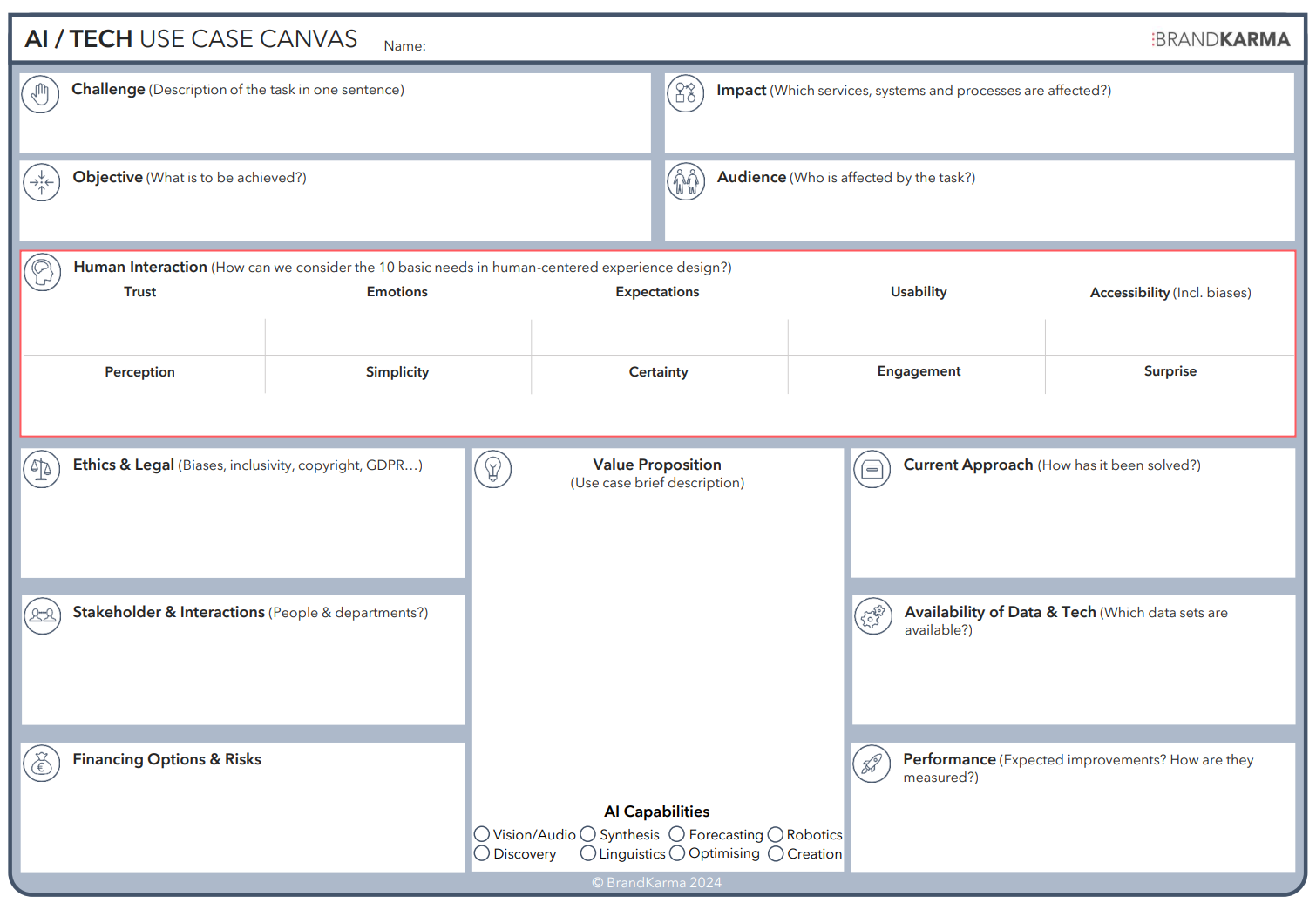AI Use Case Canvas
by Eliot Mannoia // February 19, 2024
reading time: 4 minutes

© Ylanite Koppens
In the bustling digital era, the allure of artificial intelligence (AI) is undeniable, promising transformative leaps across sectors. Yet, the path from fascination to functional implementation is less a straight road and more a labyrinth of considerations. Embarking on this journey requires a map—a guide that not only navigates the technological landscape but also respects the human experience at its core. Enter the unique one-page AI use case canvas, an innovation inspired by the seminal Business Model Canvas proposed by Alexander Osterwalder in 2005. This canvas serves as a guide for businesses venturing into the AI frontier, ensuring their journey is both grounded and guided by a human-centric approach.
At the heart of this canvas is a profound integration of digital psychology and the 10 dimensions of experience design and architecture. These dimensions, which include Trust and Credibility, Emotions, Expectations, Usability, Accessibility, Perception, Simplicity, Certainty, Engagement, and Surprise, form the foundation for creating experiences that resonate deeply with users. They acknowledge that successful AI implementation transcends technical prowess, demanding an acute understanding of human needs and emotions.
The significance of emotional intelligence in deploying AI cannot be overstated. In a landscape where technology often feels impersonal and detached, infusing AI solutions with an understanding of emotional intelligence bridges the gap between human and machine, fostering environments where technology supports and enhances human interactions rather than diminishing them.
Moreover, the canvas champions the critical themes of ethics, biases, and inclusivity. As we usher in new technologies, the imperative to navigate these ethical waters with care and consideration is paramount. The canvas prompts us to question not only the capabilities of AI but also its impact on people, ensuring that the benefits of AI are accessible to all and that its deployment is free from biases that could perpetuate inequalities.
Structured around key components—such as the challenge, impact, objective, audience, and human interaction—the canvas offers a comprehensive framework for evaluating AI use cases. It addresses the ethics and legal considerations, stakeholders, financing options and risks, current approaches, data and technology availability, performance expectations, AI capabilities used, and the overarching value proposition. This systematic approach ensures that every facet of AI implementation is scrutinised, from its practicality to its ethical implications.
The canvas’s simplicity and guiding nature democratize AI implementation, making it accessible to businesses of all sizes. Its focus on human-centric experience design ensures that AI solutions are not just technologically advanced but also meaningful and engaging for the end-users. By leveraging this canvas, businesses can navigate the complex interplay between technology and humanity, ensuring that their AI initiatives are both innovative and empathetic.
Why it matters:
In conclusion, as we stand on the precipice of widespread AI adoption, the journey ahead is fraught with challenges and opportunities. The one-page AI Use Case Canvas emerges as a vital tool, guiding businesses through this uncharted territory. By marrying the technicalities of AI with the nuances of human experience, the canvas not only optimises the implementation process but also ensures that the technology we create today shapes a future where humans remain at the heart of digital transformation.

© Eliot Mannoia BrandKarma
#brandkarma #digitalpsychologist #digitalhumanism #emotionalintelligence #business
